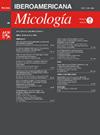Clinical insights into invasive aspergillosis among immunosuppressed patients: A single-centre experience from Argentina
IF 1.6
4区 生物学
Q4 MYCOLOGY
引用次数: 0
Abstract
Background
Invasive aspergillosis poses a significant threat to immunocompromised individuals. Diagnostic criteria incorporating biomarkers and imaging have improved diagnosis, and treatment options have expanded. However, in Argentina, diverse patient demographics and environmental factors add complexity to managing this infection.
Aims
This study aims to explore the epidemiology, diagnostic methods, and treatment of invasive aspergillosis in an Argentine hospital setting.
Methods
We collected data from patients with suspected invasive aspergillosis at a tertiary care hospital in Central-Northern Argentina. Variables included demographics, underlying conditions, diagnostic criteria, treatment, and outcomes.
Results
With a median age of 44.5 years and a 51% of male patients, our institution conducted invasive aspergillosis screenings on 192 patients, many of whom were battling malignancies (90%). One third of them had the infection set as probable or possible. Imaging (31%) and positive microbiological results (16%) were examples of diagnostic evidence. With an overall mortality rate of 15%, half of the patients got antifungal treatment for a median of seven days. Mortality among the diagnosed patients was 22%. Patients without stem-cell transplantation had a high death rate (31%), although this difference was not statistically significant; in patients having pulmonary nodules (15%) the death rate was not statistically significant either. There were no discernible variations in mortality according to the type of treatment received.
Conclusions
Our study reveals that invasive aspergillosis remains a significant issue in high-risk patients, and has a notable mortality rate, particularly among those patients with pulmonary nodules. Computed tomography provides a high diagnostic yield.
侵袭性曲霉病在免疫抑制患者中的临床见解:来自阿根廷的单中心经验。
背景:侵袭性曲霉病对免疫功能低下的个体构成重大威胁。结合生物标志物和影像的诊断标准改善了诊断,治疗选择也扩大了。然而,在阿根廷,不同的患者人口统计和环境因素增加了管理这种感染的复杂性。目的:本研究旨在探讨阿根廷医院侵袭性曲霉病的流行病学、诊断方法和治疗。方法:我们收集了阿根廷中北部一家三级医院疑似侵袭性曲霉病患者的资料。变量包括人口统计、基础条件、诊断标准、治疗和结果。结果:中位年龄为44.5岁,男性患者占51%,我院对192例患者进行了侵袭性曲霉病筛查,其中许多患者正在与恶性肿瘤作斗争(90%)。其中三分之一的人被定为可能感染。影像学(31%)和微生物学阳性结果(16%)是诊断证据的例子。总体死亡率为15%,一半的患者接受了抗真菌治疗,治疗时间中位数为7天。确诊患者的死亡率为22%。未进行干细胞移植的患者死亡率较高(31%),尽管这一差异无统计学意义;肺结节患者(15%)的死亡率也无统计学意义。根据所接受的治疗类型,死亡率没有明显的变化。结论:我们的研究表明,侵袭性曲霉病在高危患者中仍然是一个重要的问题,并且具有显著的死亡率,特别是在肺结节患者中。计算机断层扫描的诊断率很高。
本文章由计算机程序翻译,如有差异,请以英文原文为准。
求助全文
约1分钟内获得全文
求助全文
来源期刊

Revista Iberoamericana De Micologia
MYCOLOGY-
CiteScore
1.90
自引率
0.00%
发文量
17
审稿时长
81 days
期刊介绍:
Revista Iberoamericana de Micología (Ibero-American Journal of Mycology) is the official journal of the Asociación Española de Micología, Asociación Venezolana de Micología and Asociación Argentina de Micología (The Spanish, Venezuelan, and Argentinian Mycology Associations). The Journal gives priority to publishing articles on studies associated with fungi and their pathogenic action on humans and animals, as well as any scientific studies on any aspect of mycology. The Journal also publishes, in Spanish and in English, original articles, reviews, mycology forums, editorials, special articles, notes, and letters to the editor, that have previously gone through a scientific peer review process.
 求助内容:
求助内容: 应助结果提醒方式:
应助结果提醒方式:


